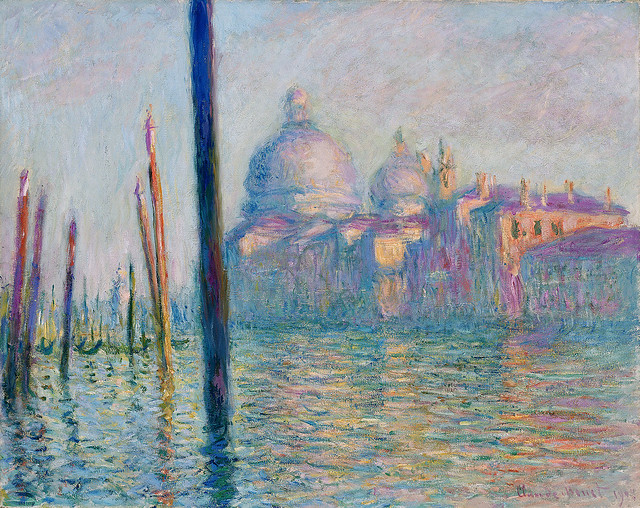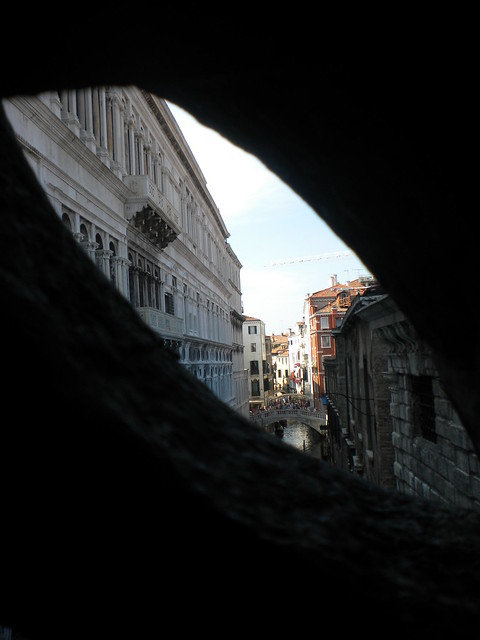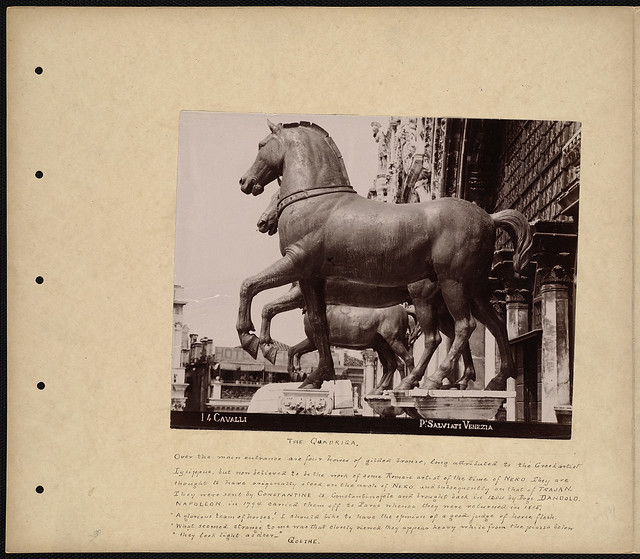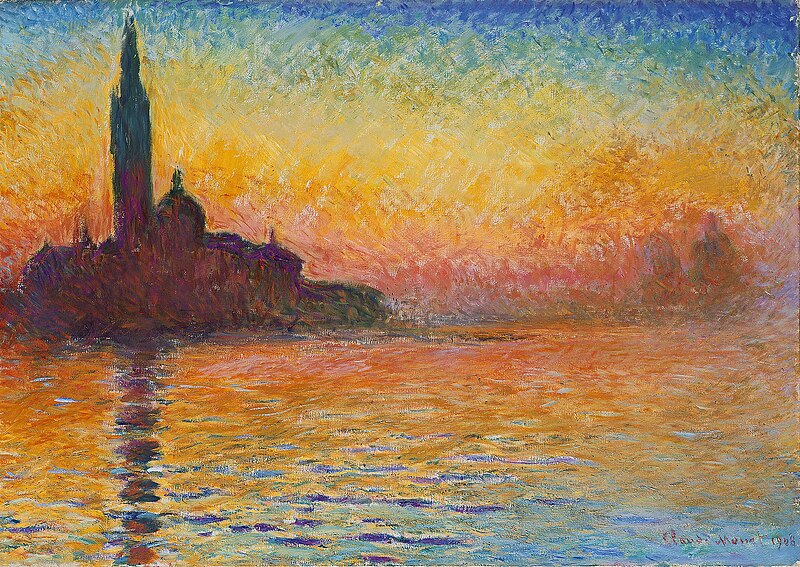I was staring the ceiling of the Museo di San Marco, Basilica di San Marci, located in the Piazza di San Marco, on the Isle di San Marco in Venice, Italy, and longing for some gelato. Despite being surrounded by the excited voices of fellow tourists, I was completely uninterested in the wonders around me. That’s when I heard a creak. Turning toward the noise, I noticed the murmur of voices had died down and I was now alone in the Museo di San Marco. I took in the four impressive figures standing restlessly before me. I say restlessly because, though made of bronze, everything about the Quadriga of St. Marks, from the lift of their hooves to the wrinkle of their noses to the twist of their necks, demonstrated motion. It was almost as if they were going to trot toward me at any moment. And then the one on the left blinked. I blinked back. The horse stretched out its long neck toward me.

Horses of Saint Mark in Venice, remnants of a quadriga of ancient Rome & Nova Roma. Wikimedia Commons: tteske
In wonder, I stroked its nose. I could have sworn the bronze was warm and velvety under my touch. With a toss of its great head, the beautiful beast beckoned me onto its back. Stepping onto the sign explaining the history of this famous foursome, I slung my leg up and took hold of its mane. It pounded past the dull facsimilehorses on the balcony and jumped out over St. Mark’s Square.

Claude Monet. The Grand Canal, Venice, 1908, oil on canvas, 73.5 × 92.5 cm, Museum of Fine Arts, Boston, Alexander Cochrane Bequest.
As we hurtled through the sky, I swear I could hear the screams of the creators of the Torre Dell O’rologio clock. The clock, featuring gold stars and astrological symbols on a face of deep blue, had awed the people of Venice. In fact, they loved it so much that they demonstrated their thanks by blinding the unfortunate craftsmen so that they could never again create a clock of such beauty.

flickr creative commons: Marcelo Teson
I could see the hustle and bustle of people below us in the square. Not just people of my day and age, but people from all different time periods in the city’s colorful history. Modern day souvenir stands sat only inches away from Middle Age bancas (benches where the earliest forms of banking took place, starting with money changers exchanging currency). I saw locals and travelers of all time periods in the city’s colorful history milling about. There were merchants selling their wares from halfway across the world and laborers unloading shipments of goods. I saw council members in their fine clothing heading in to a meeting from the time of the proud Venetian republic, walking side by side with tourists with cameras slung around their necks. Children from all time periods ran and played, ducking under stalls and chasing pigeons.

"Venice - The Square of St. Mark", Antonio Canaletto. Wikimedia Commons
I lurched forward on my horse’s back, as his hooves clattered onto the roof of the grand Doge’s Palace, landing an impossible leap. Here doges had lived in splendor with their families from the 7th century until the fall of the Venetian republic in the 18th century.

The Doge's Palace (Le Palais ducal). Monet. Wikimedia Commons: Brooklyn Museum
We leapt down onto the roof of the Ponte dei Sospiri (Bridge of Sighs). Prisoners were often led over this closed bridge on the way to their cells. I could feel the despair and hear the lamentations of the prisoners as they stared out the small carved windows, soaking in their last glimpse of the outside world.

Venice Bridge of Sighs - photo Kathryn Blanco
My host leapt from the bridge and galloped through winding streets. I could feel the power in the horse beneath me, the energy pent up for over a thousand years. I could feel the heat of the flames and hear the ringing of hammers as this great animal was fashioned on a Greek island within the Roman Empire by an unknown creator. I could feel the pride from the hundreds of years it and its siblings had spent presiding over the royal horse races in Constantinople. I heard the clanging of swords as the Venetians attacked the aforementioned city, taking the horses as war trophies. I felt the quiet despair as they languished in the Arsenale, unnoticed by the world and the glory as they once more took their place in the public eye atop the Basilica di San Marco possibly due to the insistence of Florentine ambassadors that their beauty be recognized. Then the confusion as, over a span of 184 years, they were taken to Paris by Napoleon, sent back to Venice after his defeat, sheltered at the Castel Sant’Angelo in Rome for World War I and at the Praglia Abbey during World War II, and, finally, came to rest inside St. Marks Basilica, where they stand today – except the one that was showing me Venice.

The Quadriga. Boston Public Library.
I was pulled from my thoughts of history as I noticed the world darkening around me. It was turning to night now, but the city was far from sleeping. Candlelight illuminated windows and rooftops. Music poured out on the streets. The horse leaped through a window into the ballroom of a palazzo. Figures in fine clothing and gorgeous, haunting masks twirled across the floor beneath the light of a gleaming glass chandelier. We passed unnoticed through the crowd. I realized I was no longer clothed in jeans and a T-shirt, but was instead wearing a ball gown, with a painted mask covering my face. I slipped off the back of the horse and joined the partygoers, though we still seemed to be invisible to the crowd, and danced for what felt like hours in the opulent household of a wealthy merchant.

flickr creative commons: Glenn Forrest
Bells tolled. I knew they rang from St. Mark’s bell tower. I mounted the horse, who had moved gracefully through the ballroom with me, as it leapt into action. Sooner than I would have liked, we arrived at the Piazza di San Marco. The winged lion, symbol of St. Marks, roared his welcome from atop a pillar where he was depicted, as always, with his paw placed over an open Bible. We galloped across the roof of the palace and I clutched the mane for dear life as it slowly hardened back into bronze beneath my hands. When we arrived at the Museo di San Marco, my host rudely bucked me off and hastened to take his place on the platform beside his brothers (though not before I caught a wink in my direction). And then there was darkness.
Somebody hauled me up from the floor and handed me off to my concerned parents. “Must have been the heat,”sI heard somebody remark. “Poor girl must have gotten dehydrated,” said another.
As I walked to the hotel with my family, who wouldn’t be persuaded I was “absolutely fine,” I was no longer uninterested in the history of Venice. I had lived it. From its earliest days as a safe haven from the barbarians, to the glory days where it was a powerful trade center, to its current function mainly as a tourist destination, Venice has undergone many changes over the years, each serving a purpose. The beauty that had inspired writers like Shakespeare (who had never even been to Venice) and artists like Monet to bring this fairytale city to life on paper for the world to see was so clear to me now. A few islands of refugees had grown to become a powerful republic with a strong navy, one of the centers of trade in the world. This improbable civilization had built a city on the water and from that city had come wonderful things – sleek gondolas, beautiful and frightening masks, and delicate glass creations. I was a part of it now. And I couldn’t wait to continue exploring the next morning.

Claude Monet 1908 in Venice - W 1769 - San Giorgio Maggiore, Twilight. Wikimedia Commons: Beyeler Foundation
Kathryn Blanco is a member of the Youth Travel Blogging Mentorship Program
An ununsual ride through Venice - and history
Posted by: Kathryn Blanco
